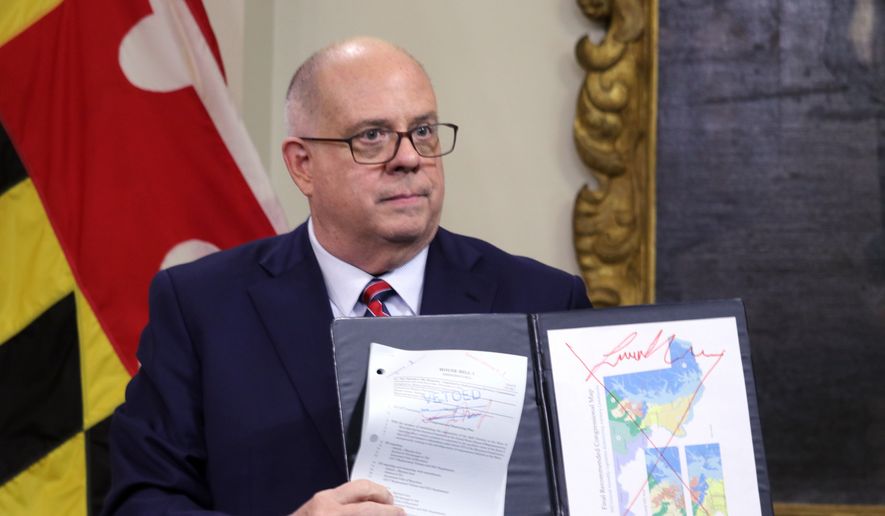ANNAPOLIS, Md. — Gov. Larry Hogan vetoed a redrawn Maryland congressional map on Thursday, and the General Assembly was scheduled to gather for votes to potentially override his veto later in the day.
The Republican governor criticized the map approved this week by the House and Senate, which are both controlled by Democrats. Hogan said the new boundaries for the state’s eight U.S. House seats are drawn even more unfairly than they were a decade ago, and he said they will be challenged in both federal and state courts.
“This is not the end of the process,” Hogan said, before signing the veto at a desk. “This is just the beginning. The courts will be the final arbiter, not the partisan legislature. These maps cannot and will not stand.”
In a state where Democrats outnumber Republicans 2-1, Democrats currently hold a 7-1 advantage over the GOP in the state’s U.S. House delegation. The map approved by lawmakers would likely maintain that advantage and potentially enable Democrats to go 8-0.
The governor had submitted a different proposal developed by a commission whose nine members he appointed. He said the three Democrats, three Republicans and three independents were citizens who would take politicians out of the process of drawing maps. Democrats contended that was hardly the case - since Hogan selected them.
Democrats, who have a supermajority in both chambers of the legislature, have the votes to override the veto in a special session on redistricting that is drawing toward a close. They’ve described it as an improvement on the current map.
The map they support was approved in a 4-2 vote by a commission with six legislators. The panel’s four Democrats, including House Speaker Adrienne Jones and Senate President Bill Ferguson, supported the map while the two Republicans, Senate Minority Leader Bryan Simonaire and House Minority Leader Jason Buckel, opposed it.
“This new map provides cleaner lines and more compact districts while keeping a significant portion of Marylanders in their current districts, ensuring continuity of representation,” Jones and Ferguson said in a joint statement Wednesday night. “It also demonstrates a steadfast commitment to the federal Voting Rights Act by ensuring that minority voters retain their ability to elect their preferred candidates.”
Democrats hold the three-fifths majority in both chambers needed to override a veto. The Senate voted 32-15 for the map on Wednesday, three more votes than the 29 they need to override a veto. The House approved it 97-42, 12 votes more than the 85 needed.
Some of the most closely watched changes affect the 1st Congressional District, which includes the Eastern Shore and is now represented by Republican Rep. Andy Harris. The change to what is now a strongly Republican district would add enough registered Democrats to outnumber Republicans, though the district would still be competitive.
A grassroots organization called Fair Maps Maryland pledged to take aggressive legal action against the map.
“Make no mistake - this level of gerrymandering is voter suppression,” said Doug Mayer, a spokesman for the group who is a former Hogan spokesman. “As a consequence of the legislature’s actions, we have been forced to obtain legal counsel and are currently exploring suits on both the state and federal levels that will prosecute the obvious Voting Rights Act and many other illegal partisan gerrymandering violations.”
Politicians across the U.S. this year have been gerrymandering - drawing districts that either pack voters of the opposing party into a few districts or split them among multiple ones to dilute their influence. Republicans have done so in such states as Georgia and Texas and Democrats have done it in Illinois and Oregon.
A new map of legislative districts for Maryland’s 188 seats in the General Assembly will be taken up in the regular session, which begins next month.
The once-a-decade redistricting process happens after the census.




Please read our comment policy before commenting.